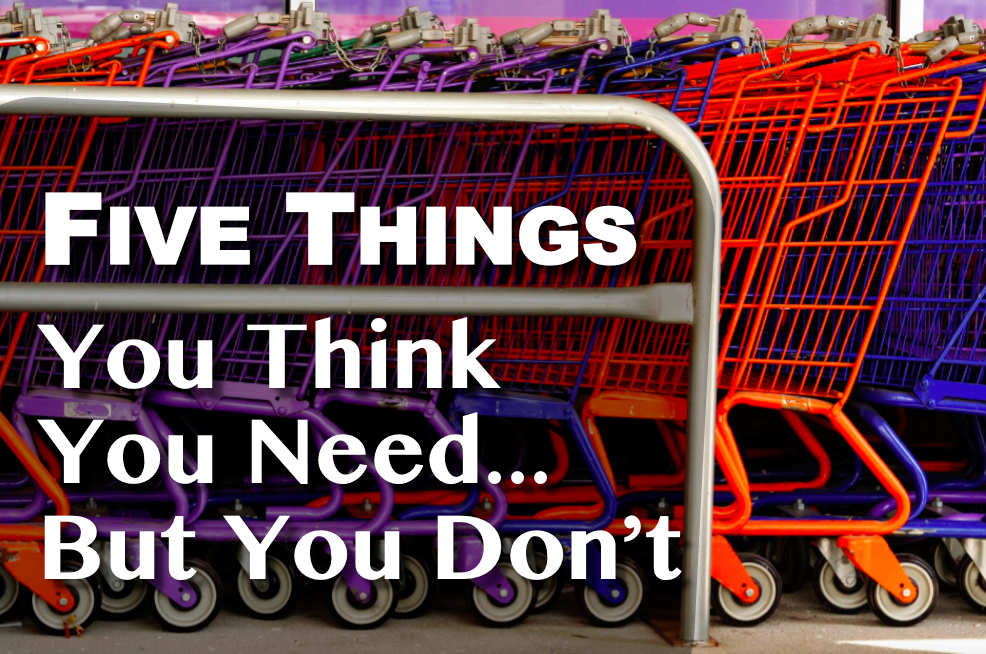Five Things You Think You Need, But You Don't
/ Not long ago, my wife and I felt like our family was on The Great Hamster Wheel to nowhere. Maybe you feel that way, too. You’re spending a ton of time and effort to earn a paycheck so you can give your family “the good life.” And now you have a lovely home and some neat toys, but you’re often too tired, too stressed, or too busy to truly enjoy it all.
Not long ago, my wife and I felt like our family was on The Great Hamster Wheel to nowhere. Maybe you feel that way, too. You’re spending a ton of time and effort to earn a paycheck so you can give your family “the good life.” And now you have a lovely home and some neat toys, but you’re often too tired, too stressed, or too busy to truly enjoy it all.
That was us.
So we decided to try a little experiment. We challenged ourselves to check out of the consumer culture for twelve months to see how it might impact our family. Before you think we’re complete whackos, realize that our challenge did not require us generate our own electricity, make underwear out of old burlap sacks, or only eat things we could kill with our bare hands. For us, it was less about saving money and more about focusing on people and shared experiences to see if it might have a positive impact on our relationships. So we lived by a simple set of rules that were restrictive, but not too crazy.
Rule #1: We wouldn’t shop for “stuff.” Sure, we could buy consumable items (think food, cleaners, hygiene products, etc.), but if it couldn’t be used up within the year, we put in the “non-essential” category.
Rule #2: If something broke, we could fix it unless we already had a suitable replacement lying around.
Rule #3: Gifts had to be in the form of charitable donations or "experiences" to be shared.
Entering this challenge, we recognized two things. First, the majority of humans on the planet live by these rules (or even more restrictive ones) out of necessity. In fact, my wife and I had spent a year serving as missionaries in Guatemala, and experienced first-hand how anything beyond food and shelter is a luxury for those living in poverty. So our experiment wasn’t really a sacrifice.
Second, there are far too many people like us in the United States who live under manufactured stress, never realizing that our never-ending quest for more is what is ultimately giving us the feeling of dissatisfaction.
While you can read about entire 12-month journey in our book, The Year without a Purchase, here are a few nuggets we have personally found helpful to review now that we’re finally allowed to shop again.
FIVE THINGS YOU THINK YOU NEED BUT YOU DON'T
1. NEW CLOTHES
My wife often asks me, “Are you naked from the waist down?”
As you might imagine, this question always captures my full attention. That is, until I realize that she is simply responding to my comment that, “I need a new pair of pants.”
Clothing is one of the big areas where we often confuse “need” with “want.” And I’m not the only one. The EPA estimates that each American throws away nearly seventy pounds of clothing per year.
Seventy pounds!
So, I only need those new pants if I am, as my wife says, in danger of getting arrested for public indecency. Otherwise, it’s an option. And our family was able to survive an entire year without buying a single stitch of clothing. And no one made fun of us.
At least not to our faces.
2. MORE STORAGE
It is estimated that the average American home contains over 300,000 items, and America itself is home to 50,000 self-storage facilities. That’s over twice the number of Starbucks locations worldwide! Our problem isn’t that we don’t have enough storage, it’s that we have too much stuff.
Often times we hold onto items because we can easily rationalize their value to us, whether it’s sentimental, or tangible. We can think of millions of situations where we might need an item. Yet, miraculously, we haven’t needed the item but one time in the past four years.
If you’re holding onto something, take the "Not Much, Not Me" challenge by asking yourself these two questions. 1) “What horrible thing would happen if I didn’t have this thing in the future?” and 2) “Who would get the most use out of this thing?” If the answers are “Not much” and “Not me,” get rid of it and get a small piece of your life back.
3. A NEW CAR
There used to be a time when auto makers touted a three-year cycle for purchasing new vehicles. Whether that was ever true is subject to debate, but the latest research shows the average age of vehicles on the road is 11.4 years.
Today, cars last far longer than they used to, and are far cheaper to maintain. Whenever you get that urge to upgrade and take on another car payment, remember this statistic: it only costs $151 more per year to maintain a car between 6-15 years old than it does to maintain a newer auto. That’s far less than a single month of payments, and the old wheels still get you from point A to point B.
4. MORE SPACE
Hypocrisy alert! It’s hard for me to write this, as my family is in the process of moving to a different home. But any time we say, “our little 1700 square foot house is too small,” we know it’s all in our heads. Even though our two extremely loud kids make the place feel like an echo chamber.
But statistics show the average American home size has nearly tripled since the 1950’s. Back then, a single family home averaged just 983 square feet. Today, it’s 2624. At the same time, the average size family has shrunk from 3.5 people to 2.5. Granted, people are bigger these days, but I’m guessing we don’t need an extra 1641 square feet for our girth alone.
Bottom line: rather than asking, “What are we missing by not having more space?” I need to remind myself to ask, “What do we gain by being closer together as a family?”
5. THE APPROVAL OF OTHERS
Ah yes! This was one of the biggest things I learned from our experiment. When I found myself wanting to buy something, whether it was different clothes or a different car, I would have to ask, “Why do you want it?” At best, I simply wanted the item because it would make my life simpler or better. Like a four slice toaster or an ultra-thin laptop for traveling.
But often, when I dug beneath the surface, there were many things I wanted because I thought they would make me better.
I am a professional, so I should get some better clothes!
How can my clients take me seriously if I show up to our meeting in my 15-year-old, compact car?
Our kitchen table looks like it’s been bouncing down a rocky cliff since the late 1980’s and just now landed in our house. What does that say about us?!
You see, “stuff” isn’t inherently bad. What is bad is the meaning we derive from it. The instant we begin to let our stuff define who we are, that’s when we start to tell Our Maker that the way he designed us just isn’t good enough. When we start to compare the cutting room floor of our own lives with the highlight reel on Facebook or TV commercials, we start to believe that perfect is normal. We start to believe that we are “less than.” We start to believe our worth is tied up in how others perceive us.
Here’s a news flash for you. There is no bigger lie.
The truth is, whatever your life situation, your stuff does not define you. In the end, the only thing we truly need is to fill ourselves to overflowing with the knowledge that we are all beautifully flawed and wonderfully made. To see ourselves as God sees us, and then give that same unconditional love to others.
I’ll buy that.
And I hope you will, too.
* Enjoy this post? For more, just preorder Scott's book about his family's Year Without A Purchase on Barnes & Noble or Amazon launching August 4th from WJK Press (We know... dripping with irony...but there's always the library!). And, to see more posts like this, submit your email at the upper right to receive new blogs hot n fresh to your inbox. Or, Like us on Facebook and follow us on Twitter @sdannemiller. Cheers!

